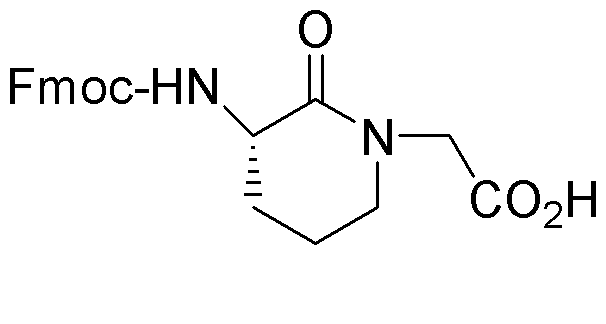Fmoc-(3S)-3-1-carboxymethyl-2-valerolactame is widely utilized in research focused on:
- Peptide Synthesis: This compound serves as a protecting group in the synthesis of peptides, allowing for the selective modification of amino acids without affecting others. This is crucial for researchers developing complex peptide-based drugs.
- Drug Development: Its unique structure aids in the design of novel pharmaceuticals, particularly in creating compounds that can interact effectively with biological targets, enhancing therapeutic efficacy.
- Bioconjugation: The chemical is used in bioconjugation processes, where it helps to attach biomolecules to drugs or imaging agents, improving their delivery and effectiveness in targeted therapies.
- Material Science: In the development of advanced materials, it acts as a building block for creating functional polymers, which can be used in coatings, adhesives, and other applications requiring specific chemical properties.
- Analytical Chemistry: This compound is employed in various analytical techniques, such as chromatography, to separate and analyze complex mixtures, providing valuable data for researchers in both academic and industrial settings.
General Information
Properties
Safety and Regulations
Applications
Fmoc-(3S)-3-1-carboxymethyl-2-valerolactame is widely utilized in research focused on:
- Peptide Synthesis: This compound serves as a protecting group in the synthesis of peptides, allowing for the selective modification of amino acids without affecting others. This is crucial for researchers developing complex peptide-based drugs.
- Drug Development: Its unique structure aids in the design of novel pharmaceuticals, particularly in creating compounds that can interact effectively with biological targets, enhancing therapeutic efficacy.
- Bioconjugation: The chemical is used in bioconjugation processes, where it helps to attach biomolecules to drugs or imaging agents, improving their delivery and effectiveness in targeted therapies.
- Material Science: In the development of advanced materials, it acts as a building block for creating functional polymers, which can be used in coatings, adhesives, and other applications requiring specific chemical properties.
- Analytical Chemistry: This compound is employed in various analytical techniques, such as chromatography, to separate and analyze complex mixtures, providing valuable data for researchers in both academic and industrial settings.
Documents
Safety Data Sheets (SDS)
The SDS provides comprehensive safety information on handling, storage, and disposal of the product.
Product Specification (PS)
The PS provides a comprehensive breakdown of the product’s properties, including chemical composition, physical state, purity, and storage requirements. It also details acceptable quality ranges and the product's intended applications.
Certificates of Analysis (COA)
Search for Certificates of Analysis (COA) by entering the products Lot Number. Lot and Batch Numbers can be found on a product’s label following the words ‘Lot’ or ‘Batch’.
*Catalog Number
*Lot Number
Certificates Of Origin (COO)
This COO confirms the country where the product was manufactured, and also details the materials and components used in it and whether it is derived from natural, synthetic, or other specific sources. This certificate may be required for customs, trade, and regulatory compliance.
*Catalog Number
*Lot Number
Safety Data Sheets (SDS)
The SDS provides comprehensive safety information on handling, storage, and disposal of the product.
DownloadProduct Specification (PS)
The PS provides a comprehensive breakdown of the product’s properties, including chemical composition, physical state, purity, and storage requirements. It also details acceptable quality ranges and the product's intended applications.
DownloadCertificates of Analysis (COA)
Search for Certificates of Analysis (COA) by entering the products Lot Number. Lot and Batch Numbers can be found on a product’s label following the words ‘Lot’ or ‘Batch’.
*Catalog Number
*Lot Number
Certificates Of Origin (COO)
This COO confirms the country where the product was manufactured, and also details the materials and components used in it and whether it is derived from natural, synthetic, or other specific sources. This certificate may be required for customs, trade, and regulatory compliance.


